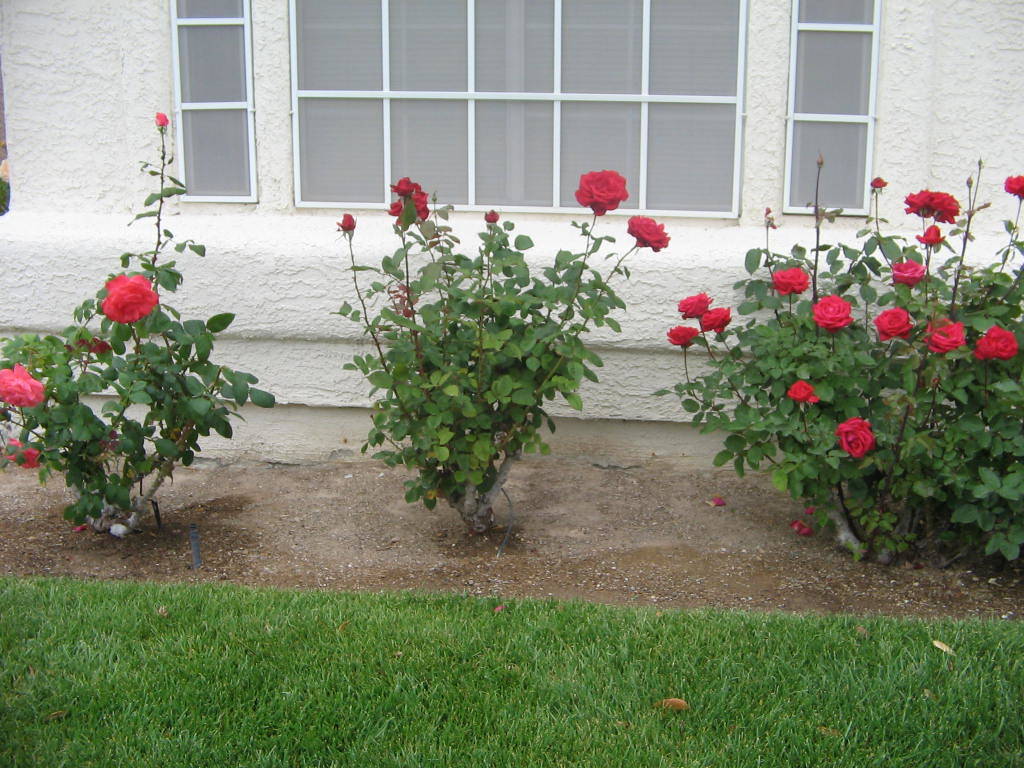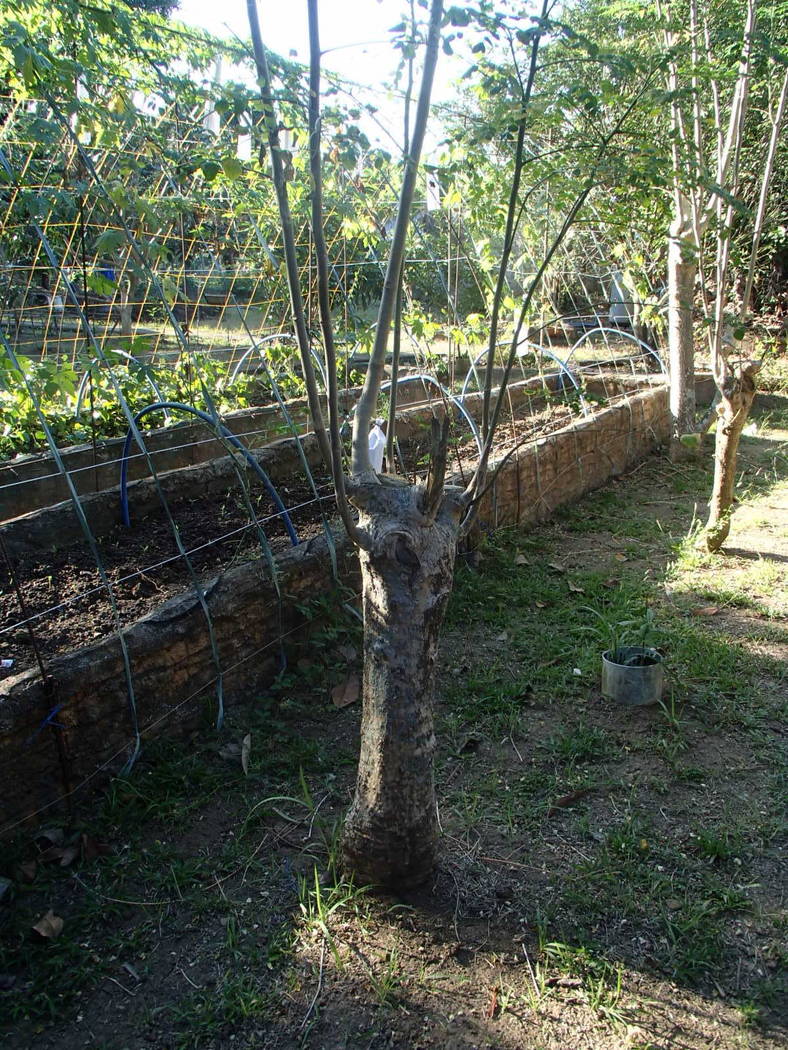Plant roses that grow well in hot desert climate
You can still attend the last of my fruit tree pruning classes starting at 9 a.m. Saturday at the Ahern Orchard near Bonanza Road and Martin Luther King Boulevard. Contact me if you need help finding this orchard. This is a private orchard and contains about 3,000 fruit trees of many kinds, ranging from one year in the ground to four years in the ground and many close to 10 feet tall.
I am getting a lot of questions sent to me on roses right now. Some highlights to remember when planting roses include going to the Weeks Roses website and looking at its rose selections by climate. Choose from its list of roses that do well in our hot desert climate before you buy one.
Use amended soil when planting or amend your existing soil with compost and dig the hole wide. Always thoroughly water roses during and after planting and stake them so the roots don’t move. Cover the soil with woodchips, not rock.
Now is the time of year for pruning roses. Make sure they are given fertilizer plus iron by the end of January. Roses in warm microclimates may not stop growing and flowering all winter long. Roses in colder microclimates lose all their leaves and, of course, stop flowering during low temperatures. Removing any remaining leaves after pruning and following this with a spray of dormant oil helps reduce pest problems during the spring and early summer.
Q: In January, my roses are all done flowering and we cut them back. However, this year I have a pod of four rose bushes, and they are all producing many flower buds and keep blooming. My question is: Should I cut them back anyway so they will regenerate for a new year? They really look beautiful right now.
A: Continuous growth through the winter can be a problem with roses in our climate if we don’t have a really cold winter or plant them in a warm landscape microclimate. Roses like cold weather.
It is very important to get your pruning done even if they are growing. It may get colder yet this year, but I would prune them back, save any flowers in a vase and remove any leaves that remain.
Removing their leaves helps push them into winter dormancy without low temperatures. They will have lots of stored reserves for new growth after pruning, so don’t worry about that. Don’t forget to apply fertilizer and iron at the end of January.
Q: Two years ago, my wife got this cute little plant for Mother’s Day, and I planted it out in my raised-bed tomato garden. After two seasons, this plant is about 4 feet tall and it looks like a Mexican palm tree. When can I transplant this into the backyard?
A: Wait until the weather starts to warm up a bit, around mid- to late February. You can plant palms all during the spring and summer months. Just avoid planting them during the mid- to late fall and winter months.
I have seen damage to palms and even death when they were planted late in the year. Death isn’t from the act of planting, but they may become more susceptible to disease at that time of the year.
Q: I have used neem oil RTU (ready to use) last year as an insecticide on my orange tree and bushes such as yellow bells and crepe myrtle. I applied it in February. It worked very well. I had no insect problems in the spring, summer or fall. Is this the same as a dormant oil spray? Does it work just as well?
A: Good to hear about the neem oil working well for you. No, it is not the same as a dormant oil application. But you could mix neem oil with dormant oil as a winter application on fruit trees immediately after pruning. Neem oil applications and dormant oil applications are not the same, but they can complement each other.
Dormant oil has a specific thickness (viscosity) that makes it better for suffocating insects that are waiting through the winter months to get back to the job of feeding on plants and multiplying when temperatures warm up. The neem oil is toxic to insects without necessarily suffocating them. Neem oil is a good choice as a general insecticide and if that is working for you, then I would encourage you to stay with it.
Now let’s mix things up a little. Apply neem oil at a slightly different time of the year, maybe a month earlier or later than normal, and see how that works. If we apply the same pesticide over and over and at the same time of year, we will get very good results on those insects that are problems at that time.
Add soap and water sprays to this arsenal and alternate their use with neem oil if you see a problem developing. This helps control a more diverse population of insects while being safer for beneficial pests and the environment.
Q: You mentioned using an auger to get down to the roots of plants and trees to aid their growth. Where do you find such a tool? Would I look in the hardware department of a store like Lowe’s?
A: This doesn’t need to be done around all plants in all soils. Augering holes, which is called vertical mulching, is for soils compacted by a lot of foot traffic, planting holes that were dug too small, and soils that don’t drain water well. Usually plants in these areas are not growing well, look sickly and may have yellow leaves.
The idea is to open poorly drained soils with multiple vertical holes and rake an amended soil mix inside these holes so roots will grow deeper and throughout the soil. Plant roots grow shallow if the soil around the roots can’t breathe. Plants growing like this are susceptible to heat and drought. Vertical mulching lets air enter deep inside the soil around plant roots.
As far as the auger goes, I have seen augers powered by an electric drill available at hardware outlets like Lowe’s that make holes about 1 in diameter. I have used these small augers, posthole diggers, as well as a hydraulic auger that creates a 6-inch-diameter hole. Not many large holes are needed. But when you create smaller holes, more holes need to be created to be effective.
Q: What are the chances of planting a moringa tree in this area? I heard about the good health benefits of morninga tea, and I’m interested in growing my own tree.
A: The moringa tree is getting a lot of attention lately because of its health benefits, but it is a tropical tree. It is known by other names that people might recognize including horseradish tree, drumstick tree and, in the Philippines, it is called malunggay. It will grow 15 to 20 feet tall if you let it.
Since it’s tropical, it will freeze to the ground if temperatures dip below freezing. However, it could be grown in Las Vegas similar to bougainvillea. Protect the base of the tree with 4 or 5 inches of mulch in late fall so the crown or roots don’t freeze during cold weather. If the tree does freeze back, it will sucker generously and vigorously from the base in the spring.
If winter temperatures get extremely low, it is possible the tree could die. Start a new one.
The moringa tree can be started from cuttings or seed. Unless you have a neighbor or friend who has a tree, the easiest way to start the tree is from seed. The seed requires warm conditions to germinate, just like tomato, so start it indoors where it can be kept warm and move it outdoors about the same time you would plant tomatoes.
The tree will grow fast — 6 feet or more in one season if it gets watered regularly and the soil is amended with compost. You can let it grow with a single trunk or cut it back close to the ground and it will produce suckers.
We grow it on our farm in the Philippines, where we keep it cut back so it suckers, and we can harvest the leaves for cooking.
Bob Morris is a horticulture expert and professor emeritus of the University of Nevada, Las Vegas. Visit his blog at xtremehorticulture.blogspot.com. Send questions to Extremehort@aol.com.
























